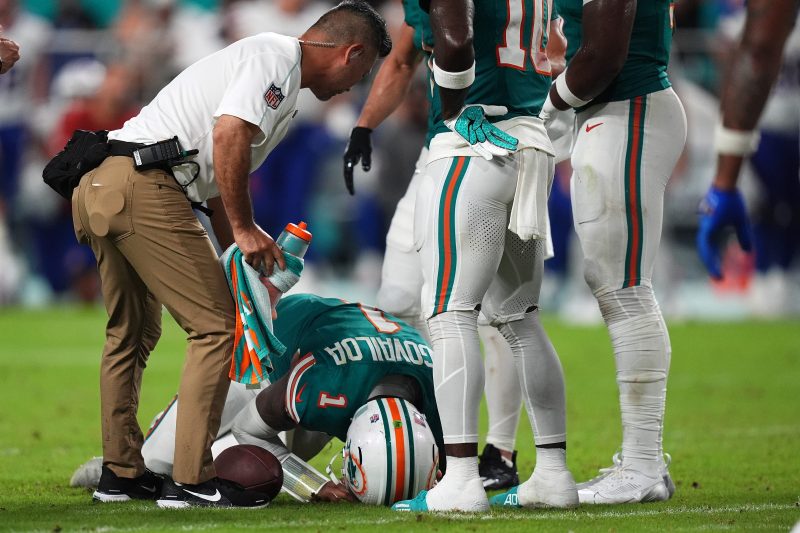
What is NFL’s concussion protocol? Explaining rules for returning
The first sentence of the NFL Head, Neck and Spine Committee’s Concussion Diagnosis and Management Protocol – more commonly referred to in the truncated ‘NFL Concussion Protocol’ – reads as such:
‘Concussion is an important injury for the professional football player.’
The injury, always in the spotlight when it comes to football, and the NFL protocols surrounding it are once again front and center after Miami Dolphins quarterback Tua Tagovailoa suffered another concussion Thursday against the Buffalo Bills.
In the upper-right hand corner of the 19-page document’s introduction, it says ‘amended as of October 8, 2022.’ That was the day an agreement between the league and the NFL Players’ Association went into effect that stated a player showing signs of ataxia during a game must be removed and not allowed to return – a change that went into effect after Tagovailoa’s concussion in September 2022 that saw him be carted off the field in Cincinnati.
Two British Journal of Sports Medicine papers about concussions in professional sports serve as the basis for the guidelines, according to the document’s references. Here is a summation of the protocols:
NFL STATS CENTRAL: The latest NFL scores, schedules, odds, stats and more.
Basic NFL concussion protocol guidelines
The first part of the protocols defines what a concussion is, along with the signs and symptoms of one. Educational materials are provided to clubs and players during the preseasons and provide basic facts while signaling the importance of reporting signs and symptoms to the medical staff. Each player receives a baseline neurological evaluation.
The game-day concussion diagnosis and management section lays out the responsibilities of the unaffiliated neurotrauma consultant (UNC) who is ‘board certified in neurology, emergency medicine, physical medicine and rehabilitation, or any primary care CAQ sports medicine certified physician or board eligible or board certified in neurological surgery, and has documented competence and experience in the treatment of acute head injuries.’ UNCs are appointed by both the league and NFLPA, and each team has one on its sideline at every game. Booth spotters also watch for injuries and can communicate via radio with the UNC or team medical staffs – and the referees should the need for a medical timeout arise.
What are the no-go signs?
These are the signs that a player must be taken off the field and to the locker room:
Loss of consciousness (including impact seizure and/or ‘fencing’ posture)
Ataxia (abnormality of balance/stability, motor coordination, slurred speech)
Confusion
Amnesia
The sideline examination is followed by a more in-depth locker room exam should the player require it. The team physician is responsible for determining whether the player is diagnosed as having a concussion.
‘The athlete may have a concussion despite being able to complete the NFL Locker Room Comprehensive Concussion Assessment ‘within normal limits’ compared to baseline, due to the potential limitations of the Assessment,’ the protocol says. ‘Such limitations underscore the importance of knowing the athlete and the subtle deficits in their personality and behaviors that can occur with concussive injury.’
Additional follow-ups
Section 5a. of the protocol outlines why checking on players after games is paramount.
‘Performing serial concussion evaluations may be useful because concussive injury can evolve and may not be apparent for several minutes or hours,’ the document says. ‘Even if a player performs at baseline or better on an initial concussion assessment and is returned to practice or play, he must be checked periodically during practice or play and again before leaving the venue.’
All players who undergo a concussion evaluation on the day of the game ‘shall have a follow up concussion evaluation’ performed the next day by the club medical staff.
Return to participation
These are the next steps Tagovailoa would have to fulfill in order to return to the field.
Phase 1: Symptom limited activity (introduction of light aerobic activity)
Phase 2: Aerobic exercise (more than 20 minutes of moderate to strenuous resistance)
Phase 3: Football specific exercise
Phase 4: Club-based non-contact training drills (participating in all non-contact practice drills)
Phase 5: Full football activity (clearance)
